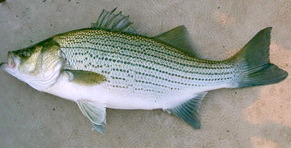Hybrid Striped Bass ( Morone hybrid)
Common Names: Striper, Sunshine bass, White bass, Palmetto bass

Hyrbid striped bass are a cross between striped bass and white bass. This cross was first produced in South Carolina in the mid 1960’s mixing eggs from a female striped bass and sperm from a white bass. These “original cross” fish are often referred to as Palmetto bass. In recent years eggs from a white bass female and a striped bass male have been mixed to create a Sunshine bass. Hybrid striped bass are a very popular sportfish throughout the Southeast, particularly in large reservoirs.
Range: Striped bass were originally found down the Atlantic coast from New Brunswick to Florida, and along the Gulf Coast from Florida to Texas. They were introduced on the west coast in the 1980’s and have sustained a reproductive population. Landlocked populations exist in many reservoirs throughout the United States where inflow stream meet spawning credentials. White bass are distributed throughout the Mississippi basin and along the Gulf Coast and have been widely introduced throughout inland waterways for the purpose of recreational fishing.
Description: Hybrid Striped bass are compressed in cross section, scaled and have looks intermediate to the two parent species. Lateral stripes similar to striped bass are seen but generally appear broken up in the area behind the pectoral fin and below the lateral line. They have two dorsal fins unconnected by tissue and the first dorsal fin is spined. The coloration grades from black to light gray dependent on the water quality of its habitat.
Biology and Life History: Hybrid striped bass do well in slow moving streams, large reservoirs, lakes and ponds and they are seldom found in shallow areas. Generally they are most active in periods of low light, such as dawn and dusk, and in late winter they tend to concentrate in deeper areas of the water body near in flowing streams. In the spring they may undergo spawning migrations to upstream areas. After growing beyond 50 mm their diets consist of mostly small fish and large zooplankton. Threadfin and Gizzard shad are the most common prey species. Maximum growth is 15 pounds and they live 3 to 5 years. Fisherman report the most common size caught is between 2 and 5 pounds. They are fertile, unlike most other hybrid species and reach sexual maturation at 2 years of age.
Stocking: A three phase introduction system has been implemented for hybrid striped bass. Phase 1, called the nursery phase consists of 3045 day old fingerlings in small fry ponds. In Phase 2 fingerlings weighing approximately one gram are stocked at a density of 12,000 to 18,000 per acre. They are harvested when weight reaches 100 to 125 g. During Phase 3 these fingerlings are stocked into grow out ponds at a rate of 3,000 to 4,000 per acre to grow to market size which is often between 1 and 2 pounds.
Adapted From:
